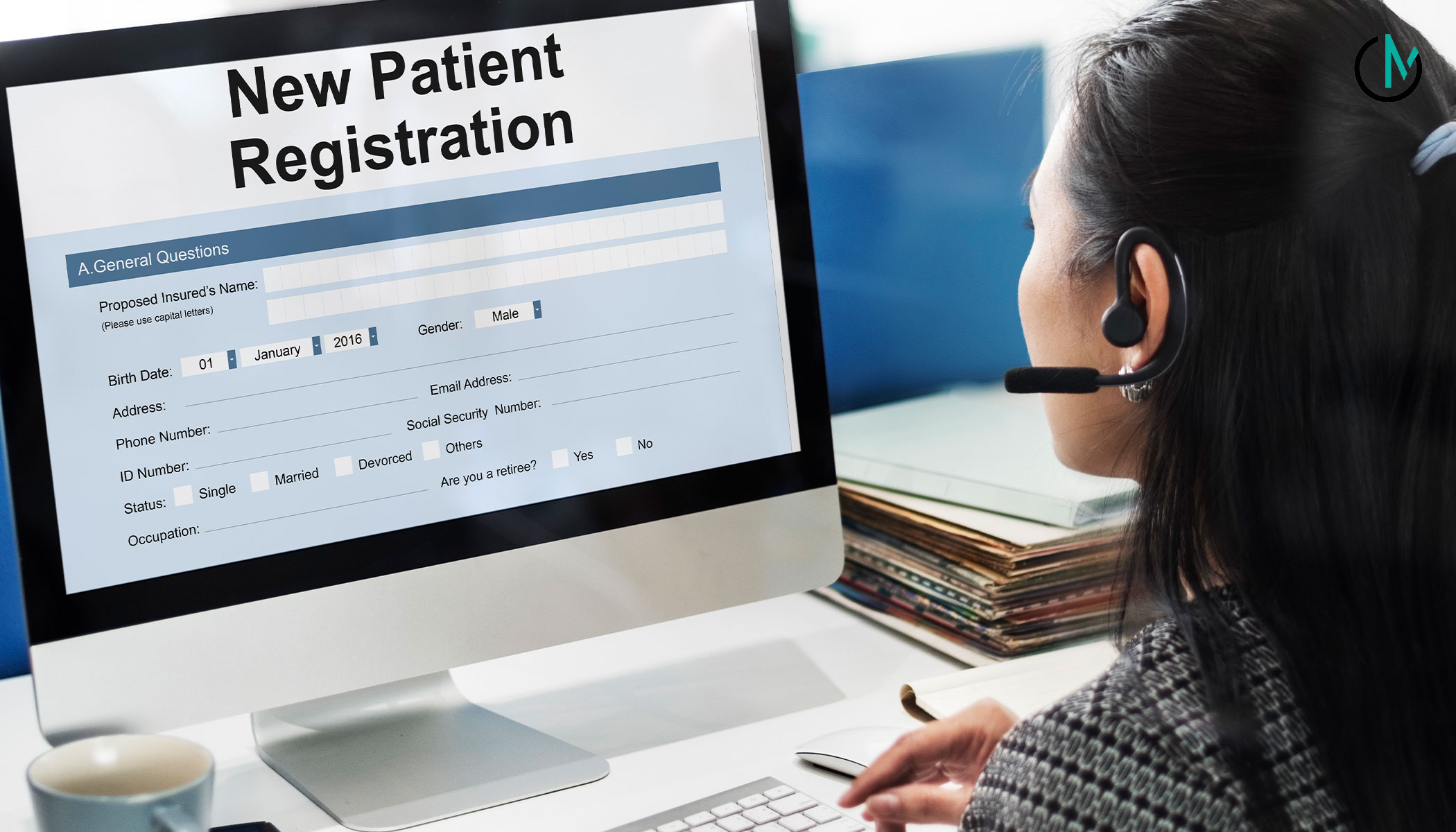What is Patient Registration in Medical Billing?
- July 18, 2025
- 0 Comments
- Patient Registration
In every healthcare practice, patient registration is the first and most important step before providing any care. It’s much more than just gathering basic details. Patient registration helps make sure patient care is properly recorded and medical billing happens smoothly, without costly mistakes or payment delays.
When patient registration is done correctly, it leads to faster insurance approvals, fewer claim denials, and quicker payments. But when important information is missed or entered incorrectly, it can cause billing issues, rejected claims, and extra work for the staff.
In this blog, you’ll learn:
- The detailed information that should always be collected during patient registration
- Why patient registration matters in medical billing and how it impacts payments
- A step-by-step guide on how to handle patient registration the right way
- The common mistakes that cause claim denials and payment delays
- How registration errors affect your revenue cycle and cash flow
- Best practices to make the patient registration process faster, easier, and more accurate
What is Patient Registration?
Patient registration is the process of collecting important information about a patient before they receive any medical care. It is the first step in every healthcare visit where basic details like the patient’s name, contact information, insurance details, and reason for the visit are gathered. This step helps set up the patient’s records in the clinic or hospital system. It also ensures that doctors and medical staff have the right information to give proper care. At the same time, it makes sure the billing team has everything they need to send claims to the insurance company.
Important Details to Collect During Registration
During patient registration, several important details are collected to make sure both patient care and billing are handled correctly. Collecting complete and correct information at this stage helps reduce billing errors, avoid claim denials, and improve patient safety.
Here’s what should always be collected:
Personal and Demographic Information
This includes the patient’s full name, date of birth, gender, address, phone number, and email. It helps create the patient’s record and ensures all communication is sent to the right place. Correct demographic details are also needed to match insurance information and avoid payment issues.
Insurance Coverage Details
This includes insurance company name, policy number, group number, and the name of the person who holds the insurance (if it’s not the patient). Collecting this information helps the billing team submit claims properly and check what services are covered before treatment.
Referring Provider Information
If the patient was referred by another doctor or specialist, their name, contact details, and referral notes should be recorded. This is especially important for specialist visits, procedures, or lab tests where insurance companies require proof of referral to approve payment.
Emergency Contacts and Guardianship Information
Patients should provide at least one emergency contact, like a family member or close friend, in case something urgent happens during the visit. For children or adults with guardians, legal guardianship details should also be collected to ensure proper consent for care.
Medical History
Some practices collect brief medical history during registration, such as past surgeries, allergies, or current medications. This helps doctors prepare for the visit and can also prevent treatment mistakes. While it may be optional in some clinics, it is often recommended to improve care quality.
Consent Forms and HIPAA Compliance Documentation
Before treatment, patients must sign certain forms. This includes consent to receive care, acknowledgment of privacy policies (HIPAA), and permission to bill insurance. These forms protect both the patient and the practice by ensuring legal and privacy rules are followed.
Why is Patient Registration Important in Medical Billing?
Patient registration is more than just a routine step. It plays a key role in how quickly and correctly a healthcare practice gets paid. When patient registration is handled properly, it helps avoid common billing mistakes and keeps the entire process running smoothly.
Here’s why patient registration is so important for every healthcare practice.
Helps Avoid Claim Denials
Wrong or missing information during registration is one of the main reasons claims get denied. Fixing errors early reduces rework and helps you get paid on time.
Makes Insurance Checks Easier
Patient registration allows the staff to check the patient’s insurance coverage before the visit. This helps confirm that the services will be covered and identifies if pre-authorization is needed. Verifying insurance during registration prevents unpaid claims and reduces billing problems after the visit.
Lowers the Risk of Billing Mistakes
Proper patient registration helps practices follow important legal rules, like HIPAA, and prevents fraud. By checking ID and insurance details carefully, practices can avoid identity mix-ups, fraudulent claims, and legal troubles related to patient privacy and billing errors.
Makes Visits Faster and Easier for Patients
When registration is done quickly and accurately, patients don’t have to waste time correcting mistakes later. A smooth check-in process means less waiting, fewer billing surprises, and a better overall experience for patients, which helps build trust in the practice.
Speeds Up Payments to Your Practice
Getting accurate patient and insurance information from the start helps billing teams submit clean claims without delays. This means the practice gets paid faster, has fewer accounts receivable problems, and enjoys better cash flow to keep daily operations running smoothly.
Common Mistakes in Patient Registration That Cause Claim Denials
Even small mistakes during patient registration can cause big problems later, especially with billing and payments. Many claim denials happen because of basic errors made at the front desk. Fixing these mistakes after the visit takes extra time and effort, and sometimes, the money may not be recovered at all.
Here are some of the most common mistakes practices should watch out for:
1. Wrong or Misspelled Patient Information - Simple typing errors like a misspelled name, wrong date of birth, or incorrect address can lead to claim rejections. Insurance companies need this information to match patient records.
2. Incorrect or Expired Insurance Details - Forgetting to update insurance information or entering the wrong policy number is one of the most common reasons for claim denials. Always double-check insurance cards during registration.
3. Missing Prior Authorization - Some procedures or treatments require approval from the insurance company before the service is given. If your staff forgets to check this, claims will likely be denied.
4. Not Checking Coverage Limits - If a patient’s insurance does not cover a service or the coverage has expired, billing the insurance will result in a denial. It’s important to verify coverage during registration.
5. Failing to Collect Copays or Deductibles - When patient responsibility amounts like copays are not collected upfront, it leads to more work later to collect payments and can cause delays in your revenue.
6. Skipping Secondary Insurance Details - Many patients have more than one insurance. Missing secondary insurance information means the practice loses out on extra payment opportunities and leaves patients with bills they shouldn’t have.
By training your front desk team to avoid these mistakes, your practice can lower the number of denied claims, reduce billing issues, and get paid faster.
Best Practices to Improve Patient Registration
- Use digital pre-registration and patient portals - Let patients fill out their details before they arrive using online forms or portals. This saves time during check-in and reduces mistakes.
- Set up automated real-time insurance verification - Use tools that automatically check if a patient’s insurance is active before their appointment. This helps avoid claim denials caused by expired or inactive coverage.
- Follow a standard registration checklist - Give your front desk team a simple checklist to make sure they collect all the important information every time, like personal details, insurance info, and consent forms.
- Train front desk staff and do regular quality checks - Teach your front desk team how to handle registration the right way. Regular training and checking their work can prevent common errors.
- Monitor performance using simple tracking tools - Use reports or dashboards to track things like the number of registration mistakes or claim denials caused by wrong information. This helps spot problems early and fix them quickly.
Conuclusion
Patient registration is more than just a simple task—it is the first and most important step in making sure your practice runs smoothly. When patient information is collected properly, it helps avoid billing mistakes, reduces claim denials, and keeps your payments coming in on time.
To sum it up:
- Correct patient registration helps prevent common billing problems.
- It makes insurance checks faster and easier.
- It improves the patient experience by reducing waiting times and confusion.
- It speeds up payments and strengthens your cash flow.
If managing patient registration is taking up too much time for your staff or causing billing problems, you can always go for professional patient registration services. This ensures the process is handled by trained experts, giving your team more time to focus on patient care. Small improvements in patient registration can lead to fewer errors, faster payments, and a better experience for everyone in your practice.






Comments (0)